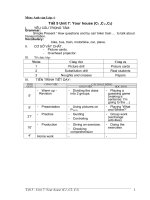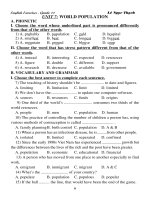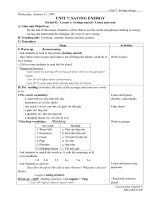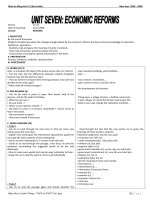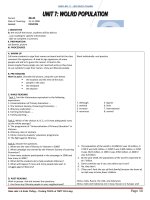Unit 7 (period 40-45)
Bạn đang xem bản rút gọn của tài liệu. Xem và tải ngay bản đầy đủ của tài liệu tại đây (240.96 KB, 7 trang )
2
0
0
8
GIÁO ÁN 11 – BỘ SÁCH CHUẨN
Period: 40-41
Date of Teaching: 15.11.2008
Lesson: READING
A. WARM UP
Call some students to sign their names on board and let the class
comment the signatures lead to sign signatures of some
people and ask Ss to guess the reason lead to the
lesson:maybe those people can not read and write,so they have
to use symbols to sign their names –they are illiterate people.
B. PRE-READING
Work in pairs. Describe the picture, using the cues below.
• the location and the time of the class
• people in the class
• the textbook
• the teacher
C. WHILE-READING
Task 1. Find the Vietnamese equivalent to the following
expressions.
1. Universalisation of Primary Education: ...
2. The Vietnam Society of Learning Promotion: ...
3. Illiteracy eradication: ...
4. Farming techniques: ...
5. Family planning: ...
Task 2. Which of the choices A, B, C, or D most adequately sums
up the whole passage?
A. The programme of “Universalisation of Primary Education” in
Vietnam
B. Illiteracy rates in Vietnam
C. Ethnic minority students’ education programme
D. The fight against illiteracy
Task 3. Answer the questions.
1. What was the rate of literacy in Vietnam in 2000?
2. What campaign was started by the Vietnam Society of Learning
Promotion?
3. How many students participated in the campaign in 2000 and
how many in 2001?
4. What did the students do to help eradicate illiteracy?
5. What will happen if more and more people take part in
struggle against illiteracy?
D. POST-READING
Work in groups. Ask and answer the questions.
1. Are there any illiterate people in your neighborhood?
A. WARM UP
Work individually: oral practice
1. Although 5. figures
2. method 6. limit
3. increase 7. international
4. resources 8. control
C. W
HILE-READING
. PO
1. The population of the world in 10,000 B.C was 10 million, in
1750 it was 625 million, in 1850 it was 1300 million, in 1950
it was 2510 million, in 1985 it was 4760 million, in 2000 it
was 6.6 billion.
2. By the year 2010, the population of the world is expected to
be 7 billion.
3. Some scientists say it can, but others say it can’t
4. No, they don’t.
5. (They can’t limit the size of their family) because the know of
no safe way to have fewer children.
China, India, Russia, the USA, and Indonesia.
China, India and Indonesia are in Asia, Russia is in Europe, and
Giáo viên: Lô Xuân Thống – Trường THCS và THPT Chi Lăng Page 58
I. OBJECTIVES
By the end of the lesson, students will be able to:
- scan reading for specific information
- able to complete a summary
II. PREPARATION
sub boards, picture
III. PROCEDURES
2
0
0
8
GIÁO ÁN 11 – BỘ SÁCH CHUẨN
2. What do you think we should do to help them read and write?
E. HOMEWORK
Write a paragraph of about 80 words to summarise the text.
F. COMMENT
the USA is in Latin America.
The richest country is the USA and the poorest country may be
India.
Period: 42
Date of Teaching: 18.11.2008
Lesson: SPEAKING
A. WARM UP
- Write the word “PROBLEMS” on the board
- Ask Ss to brainstorm the problems they often encounter at
school.
- Lead in the lesson: Let’s talk about these problems and find
solutions.
B. PRE-SPEAKING
C. WHILE-SPEAKING
Task 1. Work in pairs. Below are you some of the cause of
population explosion. Put them in them order of importance and
explain why.
□ Fewer children die at birth.
□ People are not aware of the problem of overpopulation.
□ People are not properly educated.
□ People believe that having many children means happiness.
□ Religion doesn’t encourage people to have fewer children.
□ Many people believe that having a large family is form of
insurance.
Task 2. Work in pairs. List the problems facing poor and
overpopulated countries. Then report results to the class.
Useful language:
poor living conditions
low living standards
not enough food
lack / shortage of school / hospital / teacher / doctor / nurse
Task 3. Work in groups. Work out the solutions to the problems
of overpopulation. Report your result to the class.
Useful language:
raise an awareness if the problems of overpopulation
low living standards
exercise / implement reward and punishment policies
carry out population education programmes
family planning programmes
A. WARM UP
Work in individuals: writing on board
C
Work in groups of 3: oral practice
. WHI
Then report in front of the class then.LE-READING OM
Poor living condition not enough/ expensive food
Low living standard lack/ shortage of schools/
Giáo viên: Lô Xuân Thống – Trường THCS và THPT Chi Lăng Page 59
I. OBJECTIVES
By the end of the lesson, students will be able to:
- state their viewpoints in in English
- argue, share and learn form one another
II. PREPARATION
Sub boards
III. PROCEDURES
2
0
0
8
GIÁO ÁN 11 – BỘ SÁCH CHUẨN
use birth control methods
D. POST-SPEAKING
Talk about the problems of overpopulation and offer solutions,
using the results of Task 2 and 3.
E. HOMEWORK
F. COMMENTS
hospitals/ teachers
EWORK MENTS
Period: 43
Date of Teaching: 21.11.2008
Lesson: LISTENING
A. WARM UP
B. PRE-LISTENING
Work in pairs. Discuss the following questions.
1. Do you think that our world is overpopulated?
2. What continent has the largest population?
Listen and repeat.
Latin America particularly inexpensive
developing punishment rank
improvement shortage generation
C. WHILE-LISTENING
You will hear an interview in which Dr. Brown, a world population
expert, talk about the world population. Listen to the interview and do
the tasks that follow.
Task 1. Choose the best answer A, B, C, or D for the following
statements and questions.
1.The expert says that there are ... people in the world today.
A. over 6.7 billion C. about 6.7 million
B. 6.7 billion D. 6.6 billion
2. According to the expert, the population of the world increases
by ... a year.
A. 66 million C. 76 billion
B. about 66 million D. about 76 million
3. According to expert, the area that has the highest population
growth rate is ....
A. Africa C. Latin America
B. Asia D. the Middle East
4. Scientists say that the main reason for population explosion ...
A. death rates C. an increase in death rates
B. birth rates D. a decrease in death rates
A. WARM UP
Interviewer: Good evening ladies and gentlemen. In our
program to night, we are honored to have Dr.
Brown, a world famous population expert. Dr.
Brown, could you tell us some thing about the
world population?
Dr. Brown: Well, there are over 6.700 million people in
the world to day, and the total is increasing at
the rate of about 76 million a year. Experts say
that the population of the world could be over
7 billion by the year 2015.
Interviewer: Do all parts of the world have the same rate of
population growth?
Dr. Brown: No, they don’t, The population is growing
more quickly in some parts of the world than
others. Latin America ranks first, Africa
seconds, and Asia third.
Interviewer: What is the main reason for the population
explosion?
Giáo viên: Lô Xuân Thống – Trường THCS và THPT Chi Lăng Page 60
I. OBJECTIVES
By the end of the lesson, students will be able to
- listen for specific information.
- listen and understand the message
II. PREPARATION
sub boards, cassette player,tape recorder
III. PROCEDURES
2
0
0
8
GIÁO ÁN 11 – BỘ SÁCH CHUẨN
5. Which of the following problems is NOT mentioned by the
speaker?
A. literacy C. shortage of food
B. lack of hospitals and schools D. poor living conditions
6. Which of the following solutions is NOT mentioned by the
speaker?
A. providing safe, inexpensive birth control methods
B. educating people
C. advising people to use birth control methods
D. strictly implementing a family planning polic
Answer
1 2 3 4 5 6
A D C D A C
Task 2. Listen again and answer the following questions.
1. According to experts, what will the population of the world be by
the year 2015?
2. What did the expert say about the population growth rates in
some parts of the world?
3. According to the expert, what is the reason for a fall in the death
rates?
4. According to the expert, what problems does population explosion
cause to the world, particularly to developing countries?
5. How many solutions did the expert offer and what are they?
D. POST-LISTENING
Listen again. Work in groups and summarize the main ideas of the
passage.
E. HOMEWORK
F. COMMENTS
Dr. Brown: Well, I think the main reason is a fall in death
rates. This is due to the improvement of the
living conditions and medical care.
Interviewer: I believe the explosion of population has cause
many problems. Is it right?
Dr. Brown: Yes, it is. It has caused a lot of problems such
as shortage of foods, lack of hospitals and
schools, illiteracy, and low living standards.
Interviewer: Can you make some suggestions on how to
solve these problems?
Dr. Brown: I think, there are a number of solutions to the
problems. The first is to educate people and
make them aware of danger of having more
children. The second is to provide safe,
inexpensive birth-control methods. The third is
to strictly implement a family planning policy.
And the fourth is to exercise strict and fair
reward and punishment policies.
Interviewer: Thank you very much for being with us tonight,
Dr. Brown.
Dr. Brown: You’re welcome
1. according to the expert, by the year 2010, the population
of the world will be over 7 billion.
2. He says that the population growth rates in some parts
of the world are not the same. The population grows more
quickly in some parts of the world than others.
3. According to the expert, the reason for a fall in the death
rates is the improvement of public health services and
medical care.
4. The problems(which) population explosion causes to the
world, particularly to developing countries are shortage of
foods, lack of hospitals and schools, illiteracy, and poor
living conditions.
5. The expert offers 4 solutions. They are(i) to educate
people and make them aware of the danger of having more
children, (ii) to provide safe, inexpensive birth-control
methods, (iii) to strictly implement a family planning policy,
and (iv) to exercise and fair reward and punishment
policies.
Period: 44
Date of Teaching: 24.11.2008
Giáo viên: Lô Xuân Thống – Trường THCS và THPT Chi Lăng Page 61
2
0
0
8
GIÁO ÁN 11 – BỘ SÁCH CHUẨN
Lesson: WRITING
A. WARM UP
- Show a chart and ask some eliciting questions related to the
chart.
- Lead-in: In Today’s lesson, you will learn how to describe
information from a chart
B. PRE-WRITING
ActIIIity 1: Pre-teaching vocabulary (3’)
ActIIIity 2: Some useful expressions
- The charts shows/ describes that …..
- As can be seen from the chart that…
- We can see from the chart that …
- It can be seen from the chart that …
- Globally, ….
- According to the chart, ….
- In the chart…
- In sum ….
- Comprise = account for ….. (%)
- Follow
- Make up
Outlining:
- Introduction (tell the chart is about: time, location, content…)
- Body (describe the chart in detail)
- Conclusion (summarize the main points)
C. WHILE-WRITING
Ask Ss to read the information of the chart in textbook, then ask
them to describe the chart
Go around to control and give help
Collect Ss’ writing when they have finished.
D. POST-WRITING
Choose one piece of writing and ask the whole class to correct
the mistakes.
Give comments
E. HOMEWORK
Write the passage, describing the chart into notebook.
F. COMMENTS
A. WARM UP
Individual
Whole class
- Listen and take note
Listen, guess, and note down
Individual- group
B. PRE-READING
Groupwork, write on the extra board
Suggested answer:
The chart shows the distribution of world population by regions in
2005. Gennerally, the world population is distributed unevenly
through regions.According to the chart, Asia ranks first. South
Asia accounts for 32 % while East Asia is home to 26%. Then
Europe ranks second. It comprises 15%. Africa, which is 11%,
ranks third. America follows with 8% in Latin America and 6% in
Northern America. Oceania ranks last because it comprises only
2%.
Work in groups: write on sub boards
C. WHILE-READING
D. P
DING
HOMEWORK
OMMENTS
Giáo viên: Lô Xuân Thống – Trường THCS và THPT Chi Lăng Page 62
I. OBJECTIVES
By the end of the lesson, students will be able to
- describe trends in graphs.
write s description of the information illustrated in graphs.
II. PREPARATION
Sub boards
III. PROCEDURES


